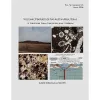Publications tagged with Volcanism
| Title | Publication Year Sort ascending | Abstract | Author | Series | Publisher | |
|---|---|---|---|---|---|---|

|
Volcanic Features of the Austin Area, Texas | 2006 | Caran, S.C., Housh, Todd, Cherepon, Alan J. | Austin Geological Society | Austin Geological Society | |

|
Tertiary volcanism of the Boficillos Mountains and Big Bend Ranch State Park, Texas: revised stratigraphy and 40Ar/39Ar geochronology | 1998 | The Bofecillos Mountains and Big Bend Ranch State Park contain a complex sequence of volcanic, volcaniclastic, and intrusive rocks that erupted from sources both within and outside the area. |
Henry, C.D., Davis, L.L., Kunk, M.J., McIntosh, W.C. | Report of Investigations | Bureau of Economic Geology |

|
Geology of the Infiernito caldera and magmatic evolution of the Chinati Mountains, Trans-Pecos Texas | 1992 | The 37-Ma-old Infiernito caldera of the northern Chinati Mountains is a major eruptive center of the mid-Tertiary volcanic field of Trans-Pecos Texas. Volcanism in the Chinati Mountains began with eruption of a sequence of rhyolitic to trachytic lavas, the precollapse lavas. |
Henry, C.D., Price, J.G., Duex, T.W., James, E.W. | Report of Investigations | Bureau of Economic Geology |

|
The Van Horn Mountains caldera, Trans-Pecos Texas: geology and development of a small (10-km squared) ash-flow caldera | 1986 | The Van Horn Mountains caldera is a small (~10-km2) igneous center in the Trans-Pecos volcanic province. The caldera formed 37 to 38 mya during eruption of the first of two ash-flow tuffs related to the caldera. |
Henry, C.D., Price, J.G. | Report of Investigations | Bureau of Economic Geology |

|
Oligocene volcanism and multiple caldera formation in the Chinati Mountains, Presidio County, Texas | 1983 | The Chinati Mountains caldera, which lies in Trans-Pecos Texas in the southern Basin and Range Province, was formed by eruption of the Mitchell Mesa Rhyolite. |
Cepeda, J.C., Henry, C.D. | Report of Investigations | Bureau of Economic Geology |

|
Calderas and mineralization: volcanic geology and mineralization in the Chinati caldera complex, Trans-Pecos Texas | 1981 | This report describes preliminary results of an ongoing study of the volcanic stratigraphy, caldera activity, and known and potential mineralization of the Chinati Mountains area of Trans-Pecos Texas. Many ore deposits are spatially associated with calderas and other volcanic centers. |
Duex, T.W., Henry, C.D. | Geological Circular | Bureau of Economic Geology |

|
Cenozoic Geology of the Trans-Pecos Volcanic Field of Texas | 1979 | Keller, G.R., Roy, R.F., Duet, N., Graham, R.G., Taylor, B., Daily, Michael, Henry, C.D., Walton, A.W. | Guidebook | Bureau of Economic Geology | |

|
Rice sands in Polk and adjoining counties, with notes on volcanic ash and bentonitic clays | 1942 | The purpose of this report is to give results of investigations made in Polk and adjoining counties. |
Shafer, G.H. | Mineral Resource Survey Circulars | |

|
Report on Volcanic Ash, Building Stone, and Gravel Deposits of Grimes County | 1936 | A mineral resource survey of Texas has been started by the Works Progress Administration, with the Bureau of Economic Geology of The University of Texas acting as sponsor. The purpose of the survey is to assemble information and make it available to the public. |
Ramsey, G.D. | Mineral Resource Survey Circulars | |

|
Volcanic Ash in Texas | 1932 | Baker, C.L. | Mineral Resource Circular | Bureau of Economic Geology |